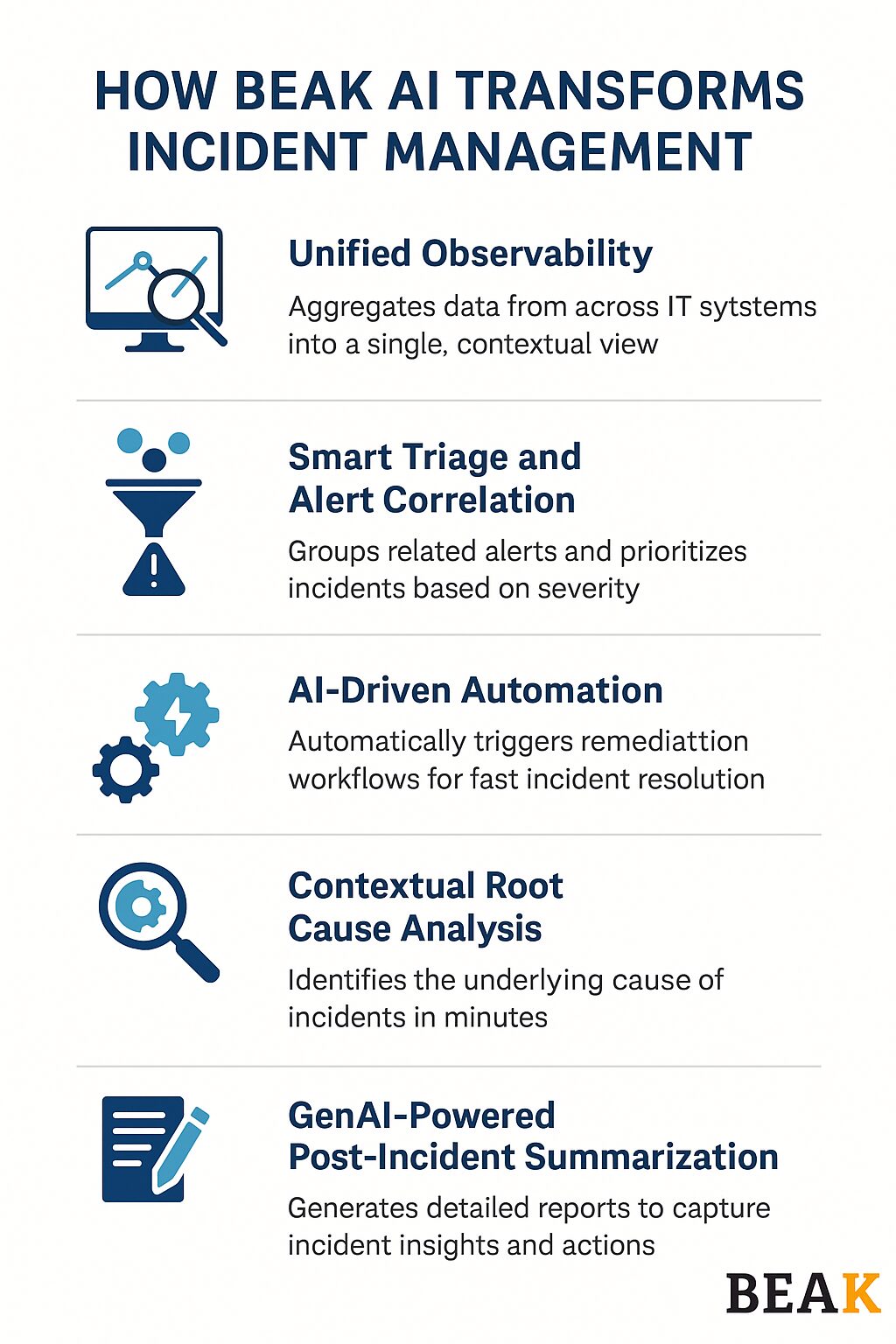BEAK AIOps for Incident Management: Reducing Downtime & IT Costs
Introduction
In modern enterprises, IT incidents are no longer just technical hiccups—they’re business disruptions. A server crash, failed update, or slow response can ripple across customers, employees, and revenue pipelines. The traditional method of “monitor, wait, and respond” is no longer enough. teams often forced to collaborate across siloed support tiers, applications, and services. This fragmented approach not only slows down investigations but also increases operational costs and the risk of repeat incidents.
Enter AI-powered incident management—a game-changer for organizations looking to boost efficiency, minimize disruptions, and ensure service reliability
The Challenges of Traditional Incident Management
Traditional incident management relied heavily on manual processes, rule-based detection, and reactive troubleshooting. These legacy approaches often struggled with alert fatigue, slow response times, and inconsistent outcomes, especially as cyber threats and system complexities escalated
- Fragmented Collaboration: Teams operate in silos, relying on manual processes that slow down investigations and escalate operational costs.
- IT ecosystems are more complex than ever before—cloud, hybrid, microservices, and third-party dependencies.
- Teams are flooded with alerts, often without clarity on which ones matter most.
- Inaccessible Knowledge: Critical incident response procedures are often buried in chat logs or lost in undocumented bridge calls, making it hard to learn from past incidents.
- Poor Documentation: Limited resources mean best practices rarely make it into SOPs or knowledge bases, leading to knowledge loss and repeated mistakes.
- Unknown Change Risks: Without contextual insights, changes frequently become the root cause of incidents, making troubleshooting a challenge.
This reactive model not only leads to longer downtimes, but also higher costs, lost productivity, and repeated issues. Today, AI is redefining the landscape, enabling a shift from reactive firefighting to proactive, intelligent operations.
How AI Is Transforming Incident Management?
- Real-Time Threat Detection and Proactive Response
AI-powered platforms continuously analyze vast streams of data—network traffic, system logs, and user behavior—to identify anomalies and potential threats as they emerge. Unlike static rule-based systems, AI models adapt to new attack patterns and operational changes, ensuring that even previously unseen threats are flagged in real-time.
- Automated Alert Prioritization and Noise Reduction
One of the most significant challenges in incident management is the overwhelming volume of alerts, many of which are false positives. AI algorithms automatically categorize and rank alerts based on severity and business impact, allowing teams to focus on what truly matters and drastically reducing alert fatigue.
- Accelerated Root Cause Analysis and Incident Summarization
AI accelerates root cause analysis by correlating data across systems and identifying patterns that would be difficult or impossible for humans to spot quickly. Modern platforms now use generative AI to summarize complex incident histories, enabling engineers to get up to speed rapidly during shift changes or escalations.
- Automated Incident Response and Self-Healing
AI-driven automation can execute predefined remediation actions—such as isolating compromised systems, restarting services, or applying patches—without human intervention. Advanced systems even offer self-healing capabilities, where incidents like failed network nodes are automatically detected, diagnosed, and resolved, restoring service with minimal downtime.
- Predictive Analytics and Preventive Maintenance
AI’s predictive capabilities allow organizations to anticipate incidents before they occur. By analyzing historical data and operational trends, AI can forecast potential failures and recommend preventive actions, slashing downtime by as much as 30–50% in some industries.
Introducing iLink’s BEAK AIOps Platform: Built for Predictable, Reliable IT
At iLink Digital, we’ve built BEAK AI to help organizations move beyond reactive operations. It’s not just another monitoring or ticketing tool—it’s a fully integrated platform that brings AI, automation, and observability into one intelligent system.
While many tools add AI as an afterthought, BEAK AI was designed from day one to deliver real-time decision-making, resolution, and prevention.
Beak Platform

How BEAK AI Transforms Incident Management?

Unified Observability
BEAK AI integrates seamlessly with your entire IT ecosystem—servers, cloud workloads, applications, monitoring tools, and service desks. It pulls signals from across these sources and presents them in a single, contextual view.
No more toggling between ten dashboards to figure out what’s going on. Teams can trace symptoms back to root causes quickly and make informed decisions, with all the evidence in one place.
Smart Triage and Alert Correlation
BEAK AI uses machine learning to analyze incoming alerts and group them intelligently. It reduces alert noise, surfaces what’s critical, and routes incidents to the right people based on severity, scope, and historical resolution patterns.
This ensures that your engineers aren’t overwhelmed by irrelevant alerts—and that real issues don’t get buried in the noise. BEAK AI also prioritizes incidents dynamically, so you’re always solving the right problems first.
AI-Driven Automation
For routine or recurring problems, BEAK AI can launch predefined remediation workflows automatically—like restarting a failed service, scaling up resources, or patching known vulnerabilities.
Instead of waiting for human intervention, BEAK AI handles low-risk fixes in seconds, reducing resolution time and preventing incident escalation. Your engineers can focus on strategic work instead of putting out the same fires.
Contextual Root Cause Analysis
BEAK AI doesn’t just tell you what happened—it helps you understand why. It analyzes logs, system changes, alerts, and past incidents to trace the likely source of the issue, often within moments.
Root cause analysis (RCA) that used to take hours now takes minutes. This accelerates response, reduces guesswork, and minimizes blame-chasing in cross-functional teams.
GenAI-Powered Post-Incident Summarization
Once the incident is resolved, BEAK AI auto-generates a comprehensive post-incident report. It includes a timeline, root cause, team actions, affected systems, resolution steps, and recommendations to prevent recurrence.
Post-mortems become quick, consistent, and actionable—without burdening engineers. Over time, this builds a robust, searchable knowledge base your entire organization can learn from. After a security alert is resolved, BEAK AI delivers a full RCA report within minutes, which is reviewed by compliance, added to runbooks, and used in future training.
Technician Copilot and Institutional Learning
BEAK AI acts as a digital assistant to your IT support staff—suggesting fixes, linking relevant documentation, and recalling past resolution history. It also logs every incident’s learnings for future reuse.
This levels the playing field for L1/L2 teams. Even less experienced staff can resolve issues quickly, reducing escalations and building confidence across the board. For instance, an L1 technician receives a ticket for a VPN connection failure. BEAK AI immediately surfaces three similar past incidents, recommends a fix, and guides the technician through it—no escalation needed
Where Intelligence Meets Efficiency: BEAK AI + iLink Managed Services
Incident management isn’t just about fixing things quickly—it’s about running IT smarter.
That’s why many organizations are turning to a combined solution: BEAK AI paired with iLink’s Managed Services. This integrated approach not only improves how you respond to issues—it helps you cut IT costs and simplify operations across the board.
Together, BEAK and iLink offer a wide range of capabilities that help teams move faster, spend less, and stay focused on strategic priorities:
What You Get | How It Helps |
Asset & Patch Management | Keeps systems secure and up to date—automatically |
Vulnerability Scanning | Spots risks early so you can act before problems occur |
Infrastructure Monitoring | Gives a clear view of system health, all in one place |
Remote Support and NOC Services | Fixes issues faster with secure, remote access |
BEAK AI Agents & Technician Copilot | Reduces support burden by guiding teams and automating common tasks |
Cloud Cost Optimization | Eliminates waste and keeps cloud usage efficient |
Software Deployment & Config Management | Speeds up onboarding and reduces setup errors |
Up to 65% Cost Savings
- Organizations using BEAK with iLink’s services have seen up to 50% savings through automation and streamlined support.
- Those who also replace fragmented tools with BEAK’s unified platform achieve up to 65% savings across tools, cloud, and labor.
The Bigger Picture: Uptime, Agility, and IT Confidence
AI-driven incident management is revolutionizing how organizations detect, respond to, and recover from incidents. By harnessing intelligent automation, businesses can reduce downtime, optimize resources, and stay ahead of threats in a world where every second counts.
With BEAK AI, incident management shifts from a reactive scramble to a proactive, confident process. BEAK AI helps you detect and resolve issues faster, prevent problems from recurring, and empower your teams with the context and tools they need. And when combined with iLink’s Managed Services, you gain a leaner, more cost-effective way to run IT—without sacrificing speed or reliability.
This is more than just improving incident response.
Whether you’re dealing with alert fatigue, rising cloud costs, or overwhelmed support desks, BEAK AI gives you the tools to unify, automate, and optimize your IT operations.
Ready to See BEAK AI in Action?
Discover how BEAK AI can cut your incident response times, reduce costs, and strengthen your digital operations.


